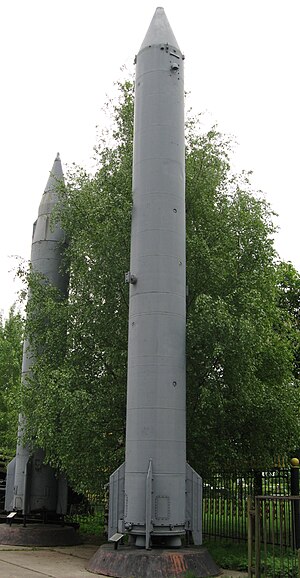R-21 (missile)
| R-21 (NATO reporting name: SS-N-5 'Sark'/'Serb') | |
|---|---|
 | |
| Type | submarine-launched ballistic missile |
| Place of origin | Soviet Union |
| Service history | |
| In service | 15 May 1963 until 1991 |
| Used by | Soviet Union |
| Production history | |
| Designer | Makeyev Rocket Design Bureau |
| Specifications | |
| Mass | 16.5 t (16.2 long tons; 18.2 short tons)[1] |
| Length | 13.0 m (42 ft 8 in)[1] |
| Diameter | 1.2 m (47 in)[1] |
| Warhead | single nuclear |
| Blast yield | 800kt or 1Mt[1] |
| Engine | liquid-fuel rocket, single stage |
Operational range | 1,300 km (700 nmi) upgraded to 1,650 km (890 nmi)[1] |
Guidance system | inertial[1] |
| Accuracy | 2.8 km CEP |
Launch platform | Golf II-class, Hotel II-class submarines |
The R-21 (Russian: Р-21; NATO: SS-N-5 'Sark/Serb'; GRAU: 4K55) was a submarine-launched ballistic missile in service with the Soviet Union between 1963 and 1989. It was the first Soviet nuclear missile that could be launched from a submerged submarine, and also had twice the range of earlier missiles. It replaced the R-11FM and R-13 (SS-N-4) on many Golf and Hotel-class submarines, and was in turn superseded by the R-27 (SS-N-6 'Serb') missile carried by Yankee-class submarines.
Development
[edit]Development of the R-15 and R-21 was initially assigned to Mikhail Yangel's Yuzhnoye Design Office (OKB-586) on 20 March 1958. The project was transferred to Viktor Makeyev's SKB-385 on 17 March 1959. It was intended for the Golf-class submarines (Project 629B); the complete missile system was called the D-4 weapon complex.[2]
The 4th Research Institute had been conducting trials of underwater missile launch systems since 1955[2] with modified Scuds [citation needed] but the first successful launch was in 1960[2] and the first flight of a standard R-21 was in 1962.[2] Over the lifetime of the missile, 193 out of 228 launches were successful.[3]
The R-21 was probably the basis for the design of the North Korean No Dong (Rodong-1) missile.[4]
Design
[edit]Unlike Western designs, the R-21 used a cold launch solid rocket to eject the missile from the flooded launch tube before the main motor ignited.[2] This allowed missiles to be launched in a water depth of 40-60 m.[5] The propulsion system used an Inhibited red fuming nitric acid-amine propellants combination, AK-27I/TG-02. The AK-27I oxidizer was a mixture of 73% nitric acid, 27% nitrogen tetroxide, and an iodine inhibitory passivant.[6] The fuel was originally used in the Wasserfall rocket under the name TONKA-250 and consisted of 50% triethylamine and 50% xylidine.[6] This gave the R-21 a range of 1,400 km (760 nmi), double that of first-generation sub-launched missiles.[5] The Naval Institute Guide suggests that the range was initially 1300 km, and extended to 1650 km later in the life of the missile.[1] There was a single warhead of approximately 800 kilotons.[1]
Variants
[edit]- R-21 (4K55) - original design
- R-21A (4K55A) - subsequent modification[2]
There was some confusion about the SS-N-4/5/6 series of missiles in the West, the SS-N-5 is normally given the NATO reporting name 'Sark' like the SS-N-4 first carried by the Golf submarines,[7] but some variants were assigned the name 'Serb' normally used for the SS-N-6.[1] Jane's uses 'Sark'.[2]
Operational history
[edit]The missiles replaced first-generation R-11FM and R-13 missiles on some Golf (Project 629) and Hotel (Project 658) class SSBNs, with three missiles per submarine,[2] between 1963 and 1967.[5] They were succeeded from 1967 by Yankee-class submarines carrying 2400 km-range R-27 (SS-N-6 'Serb') missiles.[8] Seven of the eight Hotel I (Project 658) subs were upgraded to Hotel II (Project 658M) standard, which were retired by 1991.[9]
Operators
[edit]See also
[edit]- UGM-27 Polaris - the first US ballistic missile that could be launched from a submerged submarine
References
[edit]- ^ a b c d e f g h i Polmar, Norman (1991), The Naval Institute Guide to the Soviet Navy, Naval Institute Press, p. 387, ISBN 978-0-87021-241-3
- ^ a b c d e f g h "R-21 (SS-N-5 'Sark' and 4K55)", Jane's Strategic Weapon Systems, 12 September 2008, retrieved 14 February 2009
- ^ Bukharin (2004) p319
- ^ "No Dong 1/2 (Korea, North)", Jane's Strategic Weapon Systems, 2 September 2008, retrieved 14 February 2009
- ^ a b c Bukharin; et al. (2004), Russian Strategic Nuclear Forces, MIT Press, p. 238, ISBN 978-0-262-66181-2
- ^ a b Wade, Mark. "Nitric acid/Amine TG-02". astronautix.com. Archived from the original on 29 August 2002.
- ^ Bukharin (2004) p585 for an example of the use of 'Sark'
- ^ Bukharin (2004) p240
- ^ Bukharin (2004) p292
External links
[edit]- R-21 / SS-N-5 SERB GlobalSecurity.org has many historical details
- www.aviation.ru R-21


 French
French Deutsch
Deutsch